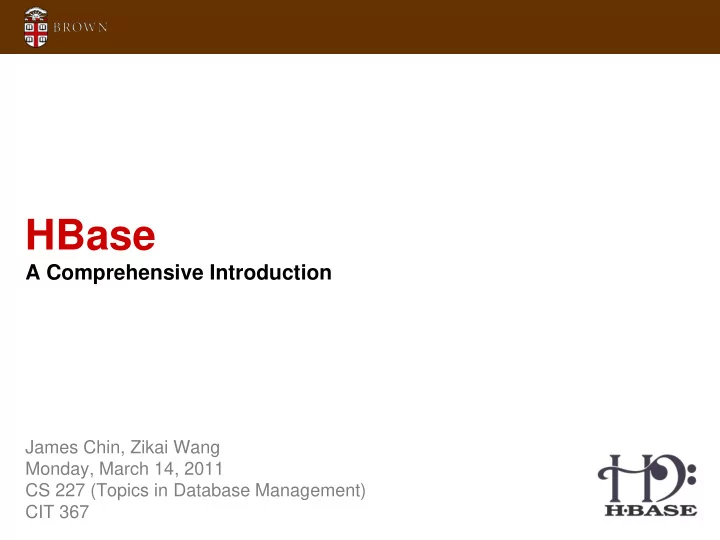

HBase A Comprehensive Introduction James Chin, Zikai Wang Monday, March 14, 2011 CS 227 (Topics in Database Management) CIT 367
Overview
Overview: History Began as project by Powerset to process massive amounts of data for natural language search Open- source implementation of Google’s BigTable Lots of semi-structured data Commodity Hardware Horizontal Scalability Tight integration with MapReduce Developed as part of Apache’s Hadoop project and runs on top of HDFS (Hadoop Distributed Filesystem) Provides fault-tolerant way of storing large quantities of sparse data .
Overview: What is HBase? Non-relational, distributed database Column ‐ Oriented Multi ‐ Dimensional High Availability High Performance
Data Model & Operators
Data Model A sparse , multi-dimensional , sorted map {row, column, timestamp} -> cell Column = Column Family : Column Qualifier Rows are sorted lexicographically based on row key Region: contiguous set of sorted rows HBase: a large number of columns, a low number of column families (2-3)
Operators Operations are based on row keys Single-row operations: Put Get Scan Multi-row operations: Scan MultiPut No built-in joins (use MapReduce)
Physical Structures
Physical Structures: Data Organization Region: unit of distribution and availability Regions are split when grown too large Max region size is a tuning parameter Too low: prevents parallel scalability Too high: makes things slow
Physical Structures: Need for Indexes HBase has no built-in support for secondary indexes API only exposes operations by row key Row Key Name Position Nationality “1” Nowitzki, Dirk PF Germany “2” Kaman, Chris C Germany “3” Gasol, Paul PF Spain “4” Fernandez, Rudy SG Spain Find all players from Spain? With built-in API, scan the entire table Manually build a secondary index table Exploit the fact that rows are sorted lexicographically by row key based on byte order
Physical Structures: Secondary Index Data Table: Row Key Name Position Nationality “1” Nowitzki, Dirk PF Germany “2” Kaman, Chris C Germany “3” Gasol, Paul PF Spain “4” Fernandez, Rudy SG Spain Index table on nationality column a scan operation Row Key Dummy start row = "Spain" “Germany 1” Germany 1 stop scanning: set a RowFilter “Germany 2” Germany 2 with a BinaryPrefixComparator on “Spain 3” Spain 3 the end value("Spain") “Spain 4” range queries are also supported Spain 4
Physical Structures: Secondary Index (cont.) Find all power forwards from Spain? A composite index Row keys are plain byte arrays Byte order = your desired order? Convert strings, integers, floats, decimals carefully to bytes Default sorting is ascending; if descending indexes are needed, reverse bit order
Physical Structures: More Indexing Lily’s HBase Indexing Library Aids in building and querying indexes in HBase Hides the details of playing with byte[] row keys HBase + full text indexing and searching systems Apache Lucene (Apache Solr, elasticsearch) Lily, HAvroBase (HBase + Solr), HBasene (HBase + Lucene)
System Architecture
System Architecture: Overview
System Architecture: Write-Ahead-Log Flow
System Architecture: WAL (cont.)
System Architecture: HFile and KeyValue
APIs
APIs: Overview Java Get, Put, Delete, Scan IncrementColumnValue TableInputFormat - MapReduce Source TableOutputFormat - MapReduce Sink Rest Thrift Scala Jython Groovy DSL Ruby shell Java MR, Cascading, Pig, Hive
ACID Properties
ACID Properties HBase not ACID-compliant , but does guarantee certain specific properties Atomicity All mutations are atomic within a row. Any put will either wholely succeed or wholely fail. APIs that mutate several rows will not be atomic across the multiple rows. The order of mutations is seen to happen in a well-defined order for each row, with no interleaving. Consistency and Isolation All rows returned via any access API will consist of a complete row that existed at some point in the table's history.
ACID Properties (cont.) Consistency of Scans A scan is not a consistent view of a table. Scans do not exhibit snapshot isolation. Those familiar with relational databases will recognize this isolation level as "read committed". Durability All visible data is also durable data. That is to say, a read will never return data that has not been made durable on disk. Any operation that returns a "success" code (e.g. does not throw an exception) will be made durable. Any operation that returns a "failure" code will not be made durable (subject to the Atomicity guarantees above). All reasonable failure scenarios will not affect any of the listed ACID guarantees.
Users
Users: Just to name a few…
Users: Facebook - Messaging System
Users: Facebook - Messaging System (cont.) Previous Solution: Cassandra Current Solution: HBase Why? Cassandra's replication behavior
Users: Twitter - People Search
Users: Twitter - People Search (cont.) Customer Indexing Previous Solution: offline process at a single node Current Solution: Import user data into HBase Periodically MapReduce job reading from HBase Hits FlockDB and other internal services in mapper Write data to sharded, replicated, horizontally scalable, in-memory, low-latency Scala service Vs. Others: HDFS: Data is mutable Cassandra: OLTP vs. OLAP?
Users: Mozilla - Socorro
Users: Mozilla – Socorro (cont.) Socorro , Mozilla’s crash reporting system (https://crash - stats.mozilla.com/products) Catches, processes, and presents crash data for Firefox, Thunderbird, Fennec, Camino, and Seamonkey. 2.5 million crash reports per week, 320GB per day Previous Solution: NFS (raw data), PostgreSQL (analyze results) 15% of crash reports are processed Current Solution: Hadoop (processing) + HBase (storage)
HBase vs. RDBMS
HBase vs. RDBMS HBase RDBMS Column-oriented Row oriented (mostly) Flexible schema, add columns on the Fixed schema fly Good with sparse tables Not optimized for sparse tables No query language SQL Wide tables Narrow tables Joins using MR – not optimized Optimized for joins (small, fast ones too!) Tight integration with MR Not really...
HBase vs. RDBMS (cont.) HBase RDBMS De-normalize your data Normalize as you can Horizontal scalability – just add Hard to shard and scale hardware Consistent Consistent No transactions Transactional Good for semi-structured data as well Good for structured data as structured data
Questions?
Thanks!
Recommend
More recommend